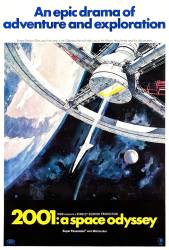Factual error: On board spaceship Discovery, the crew's living area is the spinning centrifuge, which spins about its axis to generate a gravity-like acceleration at its perimeter, the floor. When exiting the centrifuge a crewman climbs a ladder from the floor up to the hub, where there's a door leading to other parts. When Poole & Bowman climb this ladder, it's evident that they're under full body weight the whole way up. But in reality they'd get steadily lighter toward the hub. In fact, they'd be practically weightless within a few feet of it.
Factual error: In the title shot, the camera rises above the dark side of the moon, revealing the crescent of the Earth, which in turn reveals the full disc of the Sun. The Sun is surrounded by the pinpoint lights of distant stars, but there are virtually no stars visible on the darkened far left and far right sides of the screen. This is exactly opposite of how real-life astronauts describe the star scape: Astronauts say that no stars are visible when looking in the general direction of the Sun, and that stars only become visible to the human eye as you turn away from the Sun.






Suggested correction: The shuttle lands "on its back" with legs extending beyond the engines. As in most traditional sci-fi, and ALL actual, space flights to date, the launch (and landing) orientation for humans is to be on one's back. This minimizes blood being sucked down to your feet if you were sitting upright at launch - you could pass out. So we see this when the shuttle lands on the moon - the cockpit (red window) faces up (pilots on their backs, facing out the window). When we presume that the passenger cabin was 180 degrees spun around from the cockpit seating, they're still on their backs. Any loose objects would have been stowed before landing - the airlines don't lock down your bags, newspapers and coffee cups, right? They're loose in the cabin during flight, but put away on takeoff and landing.
Airliners do not fly upside down. The Orion shuttle cannot possibly operate the way it does if it lands in a gravity environment - some rooms are upside down relative to others - why else would the stewardess do the 180 degree vertical walk? It is an idiotic design flaw, and the posting is 100% correct.
The Aries passengers sit and stand with their feet down towards the moon. The pilots sit with their back down to the moon, as conventional astronauts do on Earth. But the attendant's 180-degree walk is completely wrong to the orientation of the shuttle's interior: it should have been only 90° if you look at the Aries exterior. One assumes that Kubrick preferred a longer, more cinematic shot, over a technically accurate shot. But nobody was upside-down to the moon.